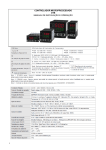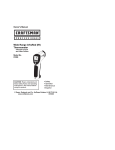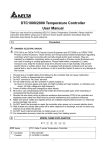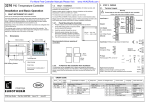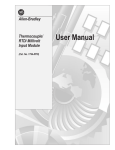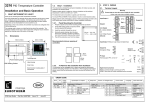Download Elenco Electronics ST-3030 Instruction manual
Transcript
OPERATOR’S INSTRUCTION MANUAL ST-3030 3¾ AC/DC DIGITAL CLAMP METER Copyright © 2008 Elenco® Electronics, Inc. Contents 1. Safety Information 3 2. Safety Symbols 4 3. General Specifications 5 4. Introduction 6 5. Features 6 6. Specifications 6,7 7. Display Details 8,9 8. Electrical Specifications 10-12 9. Operation 12-15 10. Battery Replacement 16 11. Maintenance 16 ! WARNING ! PLEASE READ THIS INSTRUCTION MANUAL CAREFULLY Misuse and/or abuse of this instruction manual cannot be prevented by any printed word and may cause injury and/or equipment damage. Please follow all these instructions and measurement procedures carefully, and adhere to all standard industry safety rules and practices. The multimeter shall be used in over voltage category II ! -2- 1. Safety Information To ensure that the meter is used safely, follow all of the safety and operation instructions in this manual. If the meter is not used as described in the manual, the safety features of the meter might be impaired. • Do not use the meter if the meter or the test leads look damaged, or if you suspect that the meter is not operating properly. • Turn off the power to the circuit under test before cutting, unsoldering, or breaking the circuit. Small amounts of current can be dangerous. • Use caution when working above 60VDC or 30VAC rms. Such voltages pose a shock hazard. • When using the test lead, keep your fingers behind the guards on the test lead. • Disconnect the live test lead before disconnecting the common test lead. • Check the main function dial and make sure it is at the correct position before each measurement. • Do not perform resistance, capacitance, temperature, diode and continuity test on a live power system. • Do not apply voltage between the test terminals and test terminal to ground that exceed the maximum limit record in this manual. • Keep the fingers after the protection ring when measuring through the clamp. • Change the battery when the “ + incorrect data. ” symbol appears to avoid • Use the DMM indoor, altitude up to 6,562 ft. (2,000m) and temperatures between 41OF and 104OF (5OC - 40OC). Maximum relative humidity 80% for temperatures up to 88OF (31OC), decreasing linearly to 50% relative humidity at 104OF (40OC). • In locations subject to radio frequency interface, the product may malfunction. It will reset automatically when leaving that environment. -3- 2. Safety Symbols ! This marking adjacent to another marking, terminal, or operating device indicates that the operator must refer to the explanation in the operating instructions to avoid damage to the equipment and/or to avoid personal injury. WARNING This WARNING sign denotes a hazard. It calls attention to a procedure, practice or the like, which if not correctly performed or adhered to, could result in personal injury. CAUTION This CAUTION sign denotes a hazard. It calls attention to a procedure, practice or the like, which, if not correctly adhered to, could result in damage to or destruction of part or all of the instrument. 500V max. This marking advises the user that the terminal(s) so marked must not be connected to a circuit point at which the voltage, with respect to earth ground, exceeds (in this case) 500 volts. This symbol, adjacent to one or more terminals, identifies them as being associated with ranges that may in normal use be subjected to particularly hazardous voltages. For maximum safety, the instrument and its test leads should not be handled when these terminals are energized. This marking indicates that equipment is protected completely by the double insulation. ~ ~ Alternating Current (AC) Direct Current (DC) Either DC or AC This symbol indicates separate collection for electrical and electronic equipment. -4- 3. General Specifications Display 3¾ digit LCD with a max. reading of 4,000 Range Control Auto range & manual range control Polarity Automatic negative polarity indication Zero Adjustment Automatic Overrange Indication The “OL” or “–OL” display Low Battery Indication Displays “ Data Hold Displays “ H ” symbol + ” symbol Relative Measurement Displays “” symbol Clamp Opening Size 32mm Auto Power Off When the measurement exceeds 10 minutes without switching modes or pressing any buttons, the meter will switch to standby mode. Press any button or rotate the selector switch to exit standby mode. When reseting the meter, press and hold the SELECT button to disable auto power off. Safety Standards EMC/LVD. CAT III 600V The meter is up to the standards of IEC1010 Double Insulation, Pollution Degree 2, Overvoltage Category III. Operating Environment Temperature 32OF to 104OF (0OC to 40OC) Humidity ≤ 80% RH Storage Environment Temperature –4OF to 140OF (–20OC to 60OC) Humidity ≤ 90% RH Power Supply 9V alkaline or carbon zinc battery (6F22 or equivalent) Dimensions 3 5/16” (W) x 8 5/8” (L) x 1 3/4” (D) 84.1mm (W) x 219mm (L) x 44.5mm (D) Weight 12 oz. / 340 g. (including battery) -5- 4. Introduction The Elenco® ST-3030 is a 3¾ (4,000 count) AC/DC digital clamp ammeter and multitester. It performs the basic electrical measurements required by service technicians. It measures AC/DC voltages, AC/DC current and resistance. It also has a diode test function and a continuity beeper. Other features include data hold min/max memory and auto power off. It is overload protected. 5. Features • 3¾ digit, 4,000 count display • AC/DC clamp-on meter • Auto/manual range • Basic accuracy: 0.5% • Diode check/continuity buzzer • Relative measurement • Data hold • Back light • Auto power off • CE/LVD CAT III 600V 6. Specifications DC Voltage 400mV/4/40/400V ±0.5%, 600V ±0.8% AC Voltage 4/40/400V ±1.0%, 400mV/600V ±0.8% DC Current 400A ±1.5%, 1,000A ±2.0% AC Current 400A ±2.0%, 1,000A ±2.5% Resistance 400Ω/4k/40k/400kΩ/4MΩ ±1.0%, 40MΩ ±2.0% Capacitance 40nF ±3%, 400nF/4μF ±2.5%, 40/100μF ±5% Frequency 10Hz - 10MHz ±1.0% Duty Cycle 0.1% - 99.9% ±2.0% Temperature –4OF - 302OF ±(5OF +2) 302OF - 1,472OF ±(3% +2OF) -6- 13 1 2 12 3 4 11 5 10 6 9 7 8 1. Transformer Jaws 2. Barrier - Hand guard holds meter below this barrier. DO NOT touch any bare wires that the jaws may be clamped around. 3. Data Hold / Light Button - Holds reading in display when the D-Hold button is pressed and released. Also turns on the back light. 4. Rotary Select Switch - Selects the function and range to measure. 5. LCD Display - Provides the measurement indications and other instrument status. 6. Hz/Duty Button - When the selector switch is set to Hz or V~, this button allows the selection of Frequency Measurement (Hz) mode or the duty cycle measurement (duty) mode. 7. VΩHz Jack - The red test lead is inserted into this jack for all measurements except current (amps). 8. COM Jack - The black test lead is plugged into this jack for all measurements except current (amps). 9. Range Button - Press this button to obtain the desired measurement range. 10. Select Button - Press this button to access the alternate measurement modes. 11. REL and DCA Zero Adjust Press this button to enter the Relative mode, zero the display, and store the displayed reading as a reference value. 12. Trigger - Opens and closes the clamp jaws. 13. Centering Marks - Locators for positioning the conductor within the jaws to obtain specified accuracy. -7- 7. Display Details Auto The Auto (ranging) annunciator is on when the meter is set to a function that has multiple ranges available. The meter is completely automatic and does not require the user to select a range. ~ The AC ~ annunciator is on when the meter is set to measure AC voltage or current. Negative Sign Annunciator - This annunciator is displayed when DC voltage being measured by the VΩHz jack is negative in respect to the COM jack. It can also be displayed in the A mode, when the measured current is in the reverse direction of the polarity arrow. Note: Polarity arrow indicates current flow from positive to negative. + Low Battery Annunciator - This annunciator is displayed when the battery needs to be replaced. H Hold Annunciator - This annunciator is displayed any time the hold mode is active. REL Annunciator - This annunciator is displayed whenever the REL mode or the DCA ZERO-ADJ mode is active. Continuity Annunciator - This annunciator is displayed whenever the Continuity (Beeper) mode is selected. Diode Test Annunciator - This annunciator is displayed whenever the Diode Test mode is selected. % Percent Annunciator - This annunciator is displayed whenever the Duty Cycle mode is selected. -8- F Fahrenheit Annunciator - This annunciator is displayed whenever the Temperature measurement mode is selected for Fahrenheit display. C Centrigrade Annunciator - This annunciator is displayed whenever the Temperature measurement mode is selected for Centrigrade display. O O Ω kΩ MΩ Resistance (Ohms) Annunciators - These annunciators are displayed whenever Resistance is being measured. The displayed annunciator indicates the range of resistance that is being measured. mV, V Voltage Annunciators - These annunciators are displayed whenever Voltage is being measured. The displayed annunciator indicates the range of voltage that is being measured. A Current (Amperes) Annunciator - This annunciator is displayed whenever the Current (Amps) measurement mode is active. nF μF mF Hz kHz MHz Capacitance (Farads) Annunciators - These annunciators are displayed whenever Capacitance is being measured. The displayed annunciator indicates the range of capacitance that is being measured. Frequency (Hertz) Annunciators - These annunciators are displayed whenever Frequency is being measured. The displayed annunciator indicates the range of frequency that is being measured. APO Auto Power Annunciator - This annunciator is displayed when the Auto Power Off mode is active. APO comes on automatically when the meter is turned on. To defeat the APO, hold the SELECT button down when turning on the power. MAX MIN MAX and MIN Annunciators - These annunciators are displayed when either MAX or MIN display has been selected (by pressing the MAX/MIN button). To exit this mode, press and hold the MAX/MIN button until the meter returns to the normal operating mode (takes about two seconds. Overload Indication - This is the display when the input exceeds the display capability of the Meter. If measuring voltage or current, remove the input immediately. Depending on the meter setting, the decimal points may or may not be present. -9- 8. Electrical Specifications Accuracies are ±(% of reading + number in last digit) at 29 ±5OC, <75% RH DC Voltage Range 400mV 4V 40V 400V 600V Accuracy ±(0.5% + 2) ±(0.8% + 3) Resolution 0.1mV 1mV 10mV 100mV 1V Overload Protection: 600VDC or AC rms Impedance: 10MΩ. More than 100MΩ on 400mV range AC Voltage Range Accuracy Resolution 400mV 4V 40V 400V 600V ±(1.5% + 3) 0.1mV 1mV 10mV 100mV 1V ±(1.0% + 2) ±(1.5% + 3) The 400mV range can be selected by pressing the “RANGE” key only. Average sensing, calibrated to rms of sine wave. Frequency: 40~400Hz Overload Protection: 600VDC or AC rms Impedance: 10MΩ. More than 100MΩ on 400mV range DC Current Range Accuracy 400A ±(1.5% + 5) 1,000A ±(2.0% + 10) Overload Protection: 1,000A DC or AC rms AC Current Range Accuracy 400A ±(2.0% + 5) 1,000A ±(2.5% + 10) Average Sensing, calibrated to rms of sine wave Frequency: 40~100Hz Overload Protection: 1,000A DC or AC rms -10- Resolution 0.1A 1A Resolution 0.1A 1A Resistance Range 400Ω 4kΩ 40kΩ 400kΩ 4MΩ 40MΩ Accuracy Resolution 0.1Ω 1Ω 10Ω 100Ω 1kΩ 10kΩ ±(1.0% + 2) ±(2.0% + 3) Overload Protection: 250VDC or AC rms Capacitance Range 40nF 400nF 4μF 40μF 100μF Accuracy Resolution 10pF 100pF 1nF 10nF 100nF ±(3.0% + 10) ±(2.5% + 5) ±(5.0% + 10) Overload Protection: 250VDC or AC rms Diode and Audible Continuity Test Range Description Display read approximately forward voltage of diode Test Condition Forward DC current approx. 0.4mA Reversed DC voltage approx. 1.5V Built-in buzzer sounds if Open circuit voltage approx. 0.5V resistance is less than 120Ω Overload Protection: 250VDC or AC rms Frequency Range 10Hz 100Hz 1kHz 10kHz 100kHz 1MHz 10MHz Accuracy Resolution ±(0.1% + 5) 0.01Hz 0.1Hz 1Hz 10Hz 100Hz 1kHz 10kHz Sensitivity: sine wave 0.6V rms (10MHz: 1.5V rms) Overload Protection: 250VDC or AC rms -11- Duty Cycle 0.1%~99.9%: ±(2.0% +2) Frequency lower than 10kHz Sensitivity: sine wave 0.6V rms Overload Protection: 200VDC or AC rms Temperature Range F O Accuracy –4~302OF 302~1472OF Resolution ±(5OF + 2) ±(3% + 2) 1OF NiCr-NiSi sensor Overload Protection: 250VDC or AC rms 9. Operation DC and AC Voltage Measurement 1. Connect the black test lead to the “COM” socket and the red test lead to the “VΩHz” socket. 2. Set the selector switch to the desired “V~” position. 3. Press the “SELECT” button to choose the “DC” or “AC” measurement. 4. Measure the voltage by touching the test lead tips to the test circuit where the value of voltage is needed. 5. Read the result on the LCD panel. 6. With the meter on the AC range, press the “Hz/DUTY” button to measure the frequency or duty cycle. DC Current Measurement 1. Set the selector switch to the desired “A ” position. 2. Zero the reading by pressing the “REL (DCA ZERO ADJ) button. 3. Disconnect the test leads from the meter. 4. Clamp the jaws around the one conductor to be measured. Center the conductor within the jaw useing the centering mark as guides. 5. Read the result on the LCD panel. The arrow on the jaw indicates the direction of positive current flow (positive to negative). -12- AC Current Measurement 1. Set the selector switch to the desired “A~” position. 2. Disconnect the test leads from the meter. 3. Clamp the jaws around the one conductor to be measured. Center the conductor within the jaw using the centering marks as guides. 4. Read the result on the LCD panel. Resistance Measurement 1. Connect the black test lead to the “COM” socket and the red test lead to the “VΩHz” socket. ) ” position. 2. Set the selector switch to the desired “Ω 3. Press the “SELECT” button to choose the resistance measurement. 4. Connect the tips of the test leads to the points where the value of the resistance is needed. 5. Read the result from the LCD panel. Note: When taking the resistance value from a circuit system, make sure the power is disconnected and all capacitors are discharged. Capacitance Measurement 1. Connect the black test lead to the “COM” socket and the red test lead to the “VΩHz” socket. ) ” position. 2. Set the selector switch to the desired “Ω 3. Press the “SELECT” button to choose the capacitance measurement. 4. Connect the tips of the test leads to the points where the value of the capacitance is needed. 5. Read the result from the LCD panel. Note: a) Before testing, discharge the capacitors by shorting the leads together. Use caution when handling capacitors because they may have a considerable charge on them before discharging. b) Before testing, pres the “REL (DCA ZERO ADJ)” button to eliminate the zero error. c) When testing 100μF capacitors, note that there will be a time lag of approximately 15 seconds. -13- Diode and Audible Continuity Test 1. Connect the black test lead to “COM” socket and the red test lead to the “VΩHz” socket. ) ” position. 2. Set the selector switch to desired “Ω 3. Press the “SELECT” button to choose either a diode or audible continuity measurement. 4. Connect the test leads across the diode under measurement, the display shows the approximate forward voltage of this diode. 5. Connect the test leads to two points of a circuit. If the resistance is lower that approximately 120Ω, the buzzer will sound. Note: Make sure the power is disconnected and all capacitors discharged before taking this measurement. Frequency and Duty Cycle Measurement 1. Connect the black test lead to “COM” socket and the red test lead to the “VΩHz” socket. 2. Set the selector switch to desired “Hz” position. 3. Press the “Hz/DUTY” button to choose either a frequency or duty cycle measurement. 4. Connect the probe across the source or load under measurement. 5. Read the result on the LCD panel. Temperature Measurement 1. Connect the black test lead to “COM” socket and the red test lead to the “VΩHz” socket. 2. Set the selector switch to desired “F” position. 3. Put the sensor probe into the temperature field under measurement. 4. Read the result on the LCD panel. Data Hold On any range, press the “D.HOLD” button to lock the display value, and the “ H ” symbol will appear on the display. Press it again to exit. -14- Back Light On any range, press the “D.HOLD” button for over two seconds to light the backlight. Press it again for more than two seconds to wink the light. Relative Measurement Press the “REL” button. You can measure the relative value and the “” symbol will appear on the display. The auto range mode will be changed to manual mode. Press it again to exit the relative measurement and the “” symbol will disappear, but you cannot return to the auto range mode. This function can be used to zero the reading on the DCA range. This function is non-effective on the Hz/DUTY measurement. Auto/Manual Range The auto range mode is a convenient function, but it might be faster to manually set the range when you measure values that you know to be within a certain range. To select the manual range, press the “RANGE” button repeatedly until the display shows the desired range. The range steps upward as you press the “RANGE” button. The meter will go back to auto range mode when you press the “RANGE” button for more than two seconds. It cannot select the manual range mode on Hz/DUTY, capacitance, or temperature ranges. Caution: While using the manual range mode, if “OL” appears on the display, immediately set the clamp meter to a higher range. -15- 10. Battery Replacement 1. When the battery voltage drops below the proper operating range, the “ + ” (low battery) symbol will appear on the LCD display. 2. Before changing the battery, set the selector switch to the “OFF” position. Open the battery compartment cover with a phillips screwdriver. 3. Replace the old battery with a new one of the same type. 4. Close the battery cover and secure it with the screw. Caution: Properly dispose of the batteries as stated in your local rules and regulations. Note: There are no fuses in this meter. 11. Maintenance 1. Before you open the battery cover, disconnect both test leads and never use the meter while the battery cover is removed. 2. To avoid contamination or static damage, do not touch the circuit board without proper static protection. 3. If the meter is not going to be used for a long time, take out the battery and do not store the meter in high temperature or high humidity environment. 4. While taking a current measurement, keep the cable at the center of the clamp to achieve an accurate test result. 5. Repairs or servicing not covered in this manual should only be performed by qualified personnel. 6. Periodically wipe the case with a dry cloth and detergent. Do not use abrasives or solvents on the meter. Elenco® Electronics, Inc. 150 Carpenter Avenue Wheeling, IL 60090 (847) 541-3800 Website: www.elenco.com e-mail: [email protected]
















